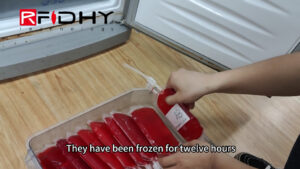
Etiquette anti-liquide 2
d'abord, Les étiquettes anti-liquides RFID ont un large éventail d'applications. Dans de nombreux secteurs, surtout dans la fabrication, logistique, et les secteurs de la santé, le suivi et la gestion des objets dans des environnements liquides sont cruciaux. Par exemple, dans l'industrie de production d'aliments et de boissons, le suivi et la gestion des stocks de contenants de liquides sont essentiels pour garantir la qualité et la sécurité des produits. Les étiquettes RFID traditionnelles sont sujettes aux interférences ou aux dommages dans les liquides, tandis que les étiquettes anti-liquides RFID peuvent fonctionner pendant des périodes prolongées dans des environnements liquides tout en conservant de bonnes performances.
Deuxièmement, Les étiquettes anti-liquides RFID offrent plusieurs avantages. Ils présentent une grande durabilité et des capacités imperméables. Ces étiquettes sont généralement fabriquées à partir de matériaux spéciaux qui peuvent résister à la pénétration des liquides et maintenir l'intégrité de l'étiquette.. en outre, Les étiquettes anti-liquides RFID démontrent d'excellentes performances de lecture et d'écriture. Que ce soit dans des environnements liquides ou quasi-liquides, ces balises peuvent lire et écrire des données avec précision, assurer un suivi précis des objets et un enregistrement des informations. aditionellement, Les étiquettes anti-liquides RFID peuvent être intégrées de manière transparente aux systèmes RFID existants sans modifications ni investissements importants.
toutefois, l'application d'étiquettes RFID anti-liquides présente également certains défis. d'abord, la distance de lecture et d'écriture des étiquettes anti-liquides RFID peut être affectée en raison de l'interférence des liquides avec les ondes électromagnétiques. Donc, un examen attentif des conditions environnementales pour la transmission et la réception du signal est nécessaire lors de la conception et du déploiement de ces balises. Deuxièmement, les environnements liquides peuvent contenir plusieurs objets, ce qui peut entraîner des interférences et des collisions entre les balises. Donc, Des stratégies appropriées de disposition des balises et de planification des signaux doivent être utilisées pour assurer une communication normale et une transmission de données entre les balises..

Etiquette anti-liquide 3
Pour surmonter ces défis, les chercheurs et les entreprises technologiques travaillent en permanence pour améliorer les performances et la fiabilité des étiquettes RFID anti-liquides. Par exemple, they are developing new materials to enhance the tags’ waterproof capabilities and anti-interference abilities. Simultanément, ils explorent de nouveaux protocoles et algorithmes de communication pour optimiser la communication et la transmission de données entre les balises. aditionellement, des systèmes RFID intelligents sont également en cours de développement, permettant la surveillance et la gestion en temps réel des objets dans des environnements liquides, améliorant ainsi l'efficacité globale de la production et l'efficacité logistique.
En conclusion, Les étiquettes anti-liquides RFID ont des implications significatives pour le suivi et la gestion des objets dans des environnements liquides. Ils fournissent des solutions innovantes pour le suivi et la gestion des objets dans des environnements liquides. Malgré quelques difficultés lors de l'application, avec une recherche continue et des avancées technologiques, Les étiquettes anti-liquides RFID joueront un rôle crucial dans divers domaines, améliorer l'efficacité de la logistique, et améliorer la qualité et la sécurité des produits. Nous attendons avec impatience de nouvelles avancées et applications de la technologie des étiquettes anti-liquides RFID à l'avenir..





